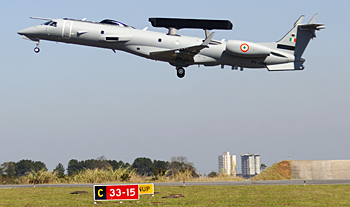- Prime Minister Narendra Modi inaugurates Aero India 2023 in Bengaluru; Releases Commemorative Stamp
- Defence Secretary meets delegations from Saudi Arabia, USA and Oman on the sidelines of Aero India 2023
- Foreign Ministers of 32 countries to attend Aero India 2023
- Embraer showcases the C-390 Millennium at Aero India 2023
Indo-Brazilian AEW&C to Enter IAF Service

The quietness of this aircraft belies the enormous interest it has evoked in the regional market already. It’s return to Aero India this year is, therefore, no big surprise. The Indo-Brazilian EMB-145I airborne early warning & control (AEW&C) aircraft is the near the end of development and systems flight trials. The Defence Research & Development Organisation (DRDO), which has developed the heart and brains of the platform, is looking to begin user flight trials any time after April, with an induction window of before Christmas. Given how smoothe things have been on the programme so far, it looks good.
Inquiries began pouring in six months ago on the platform, and possible demonstrations of its capabilities. While the EMB-145I is obviously a sensitive project involving advanced sensors and proprietary electronics developed inhouse by Indian laboratories, you will see foreign interest in the aircraft at this year’s show. Delegations, military teams and others from the region will be given tours of the aircraft and briefed on its capabilities. Memoranda of understanding on further information exchange on the programme could be signed with certain countries. A significant level of interest has been shown from West Asia, South East Asia and Latin America, traditional markets for Indian defence exports, with vast potential for more.
Dr Sargunaraj Christopher, Director of Centre for Airborne Systems (CABS) said, “The lightweight jet is capable of operation from almost any air airfield. More importantly, the network centric sensor system enables joint battle management from air, land and sea. Towards this ground systems are available to enable the operators to plan the mission, communicate the complete information from the aircraft to the command and control centres via multiple data links. A comprehensive training station is available to train the operators on all the aspects of the mission on the ground. A automated test equipment system also is available which enables trouble shooting at LRU level. Currently though the system is customised for the Indian Air force, the AEW&C India can fine tuned to any specific user oriented early warning product through appropriate programming/software which can be defined by the user.”
Developing the active array antenna unit and other electronics and sensor packages on the programme hasn’t been easy, though the IAF and DRDO were clear that this had to be entirely an in-house effort. Said Dr Christopher, “While India has caught up with the rest of the world in adopting the Active Electronically Steering Array (AESA) Antenna for its radar; the two building-block components of the radar, the Transmit- Receive Multi-Module (TRMM) and the teflon-clad ultra light Antenna Panel are notable Indian innovations in the radar sub-system. These are developed by CABS and with a joint patent along with M/s Astra Microwave, Hyderabad for TRMM. The most important outcome of the efforts is the realisation of a system that is both operation-efficient and cost-effective.”
An already satisfied primary customer has given the thumbs up. It remains to be seen who else will.





